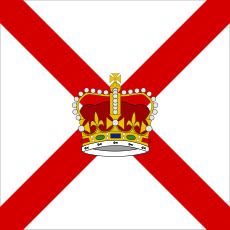Industry Shipping Founder James Macqueen Defunct 1932 | Successor Royal Mail Lines Ltd Key people Lord Kylsant Founded 1841 Fate Liquidation | |
 | ||
The Royal Mail Steam Packet Company was a British shipping company founded in London in 1839 by a Scot, James MacQueen. The line's motto was Per Mare Ubique (everywhere by sea). After good and bad times it became the largest shipping group in the world in 1927 when it took over the White Star Line.
Contents
The company was liquidated and its assets taken over by the newly formed Royal Mail Lines in 1932 after financial trouble and scandal; over the years RML declined to no more than the name of a service run by former rival Hamburg Süd.
History as Royal Mail Steam Packet Company
Queen Victoria granted the initial Royal Charter of Incorporation of "The Royal Mail Steam Packet Company" on 26 September 1839. In 1840 the Admiralty and the Royal Mail Steam Packet Company made a contract in which the latter agreed to provide a fleet of not fewer than 14 steam vessels for the purpose of carrying all Her Majesty's mails, to sail twice every month to Barbados in the West Indies from Southampton or Falmouth. Fourteen new steam vessels were built for the purpose: Thames, Medway, Trent, and Isis (built at Northfleet); Severn and Avon (built at Bristol); Tweed, Clyde, Teviot, Dee, and Solway (built at Greenock); Tay (built at Dumbarton); Forth (built at Leith); and Medina, (built at Cowes). In reference to their destination, these vessels were known as the West Indies Mail Steamers.
The West Indian Mail Service was established by the sailing of the first Royal Mail Steam Packet, PS Thames from Falmouth on 1 January 1841. A Supplemental Royal Charter was granted on 30 August 1851 extending the sphere of the Company's operations. In 1864, the mail service to the British Honduras was established. A further Supplemental Royal Charter was granted extending the sphere of the Company's operations on 7 March 1882.
In the decade before the First World War the RMSP modernised its fleet, introducing a series of larger liners ranging from 9,588 GRT to 15,551 GRT on its Southampton – Buenos Aires route. Each had a name beginning with the letter "A", so collectively they were called the "A-liners" or the "A-series". The first was RMS Aragon in 1905, followed by sister ships Amazon, Araguaya and Avon in 1906, Asturias in 1908, Arlanza in 1912, Andes and Alcantara in 1913 and Almanzora in 1915. Earlier members of the series, from Aragon to Asturias, had twin screws, each driven by a four-cylinder quadruple-expansion steam engine. The final four members of the series, from Arlanza to Almanzora, had triple screws, with the middle one driven by a low pressure Parsons steam turbine.
After the First World War RMSP faced not only existing foreign competition but a new UK challenger. Lord Vestey's Blue Star Line had joined the South American route and won a large share of the frozen meat trade. Then in 1926–27 Blue Star introduced its new "luxury five" ships Almeda, Andalucia, Arandora, Avelona and Avila to both increase refrigerated cargo capacity and enter the passenger trade. At the same time RMSP introduced a pair of new 22,200 GRT liners, RMS Asturias in 1926 and RMS Alcantara in 1927, which at that stage were the largest motor ships in the World. Although these were the biggest and most luxurious UK ships on the route, RMSP Chairman Lord Kylsant called Blue Star's quintet "very keen competition".
Reconstitution as Royal Mail Lines
The company ran into financial trouble, and the UK Government investigated its affairs in 1930, resulting in the Royal Mail Case. In 1931 Lord Kylsant was jailed for 12 months for misrepresenting the state of the company to shareholders. So much of Britain's shipping industry was involved in RMSPC that arrangements were made to guarantee the continuation of ship operations after it was liquidated. Royal Mail Lines Ltd (RML) was created in 1932 and took over the ships of RMSPC and other companies of the former group. The new company was chaired by Lord Essendon.
The new company's operations were concentrated on the west coast of South America, the West Indies and Caribbean, and the Pacific coast of North America; the Southampton – Lisbon – Brazil – Uruguay – Argentina route was operated from 1850 to 1980. RML was also a leading cruise ship operator.
RMS's largest vessel was the 25,895 GRT turbine steamship RMS Andes. She was designed as an ocean liner but when launched in 1939 was immediately fitted out as a troopship. She finally entered civilian liner service in 1948, was converted to full-time cruising in 1960 and was scrapped in 1971.
RMSP and RML lost a number of ships in their long history. One of the last was the 17,547 GRT turbine steamship RMS Magdalena, which was launched in 1948 and grounded and sank off Brazil on her maiden voyage in 1949.
In 1965 RML was bought by Furness, Withy & Co., and rapidly lost its identity. In the 1970s parts of the Furness Withy Group, including RML, were sold on to Hong Kong shipowner C.Y. Tung, and later sold on to former River Plate rival Hamburg Süd; by the 1990s Royal Mail Lines was no more than the name of a Hamburg-Süd refrigerated cargo service from South America to Europe.
For conciseness smaller ships such as schooners and lighters are omitted.
This list is of the additional vessels acquired by RML in addition to those passed directly from RMSP.
